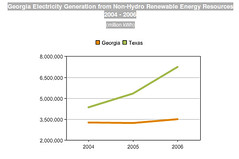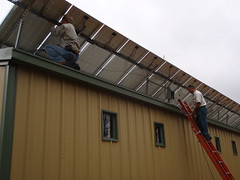-jsq
 Re: Forester R. Wayne Bell’s points of May 20, 2010. (Hi Wayne; I’ll get those dibbles back to you soon.)
Re: Forester R. Wayne Bell’s points of May 20, 2010. (Hi Wayne; I’ll get those dibbles back to you soon.)
Where does Georgia Power say Albany’s biomass plant will reduce carbon dioxide emissions by 95 percent? Biomass proponents usually say what Forester Bell says: trees are carbon neutral. That ignores the time gap between clearcutting and new growth. That gap from 15 to 100 years or more can produce a lot of CO2.
 As a tree farmer myself, I know the pulpwood market is down in Georgia due to the recession and foreign competition. I’d like to be convinced that biomass is the new market we need, but the more I look into it,
the more obfuscation I encounter.
As a tree farmer myself, I know the pulpwood market is down in Georgia due to the recession and foreign competition. I’d like to be convinced that biomass is the new market we need, but the more I look into it,
the more obfuscation I encounter.
Forester Bell seeks a study showing solar will work in Georgia. Georgia Power’s web pages (renewable energy -> solar -> solar potential)
http://www.georgiapower.com/spotlightsolar/solar_potential.asp
include a map of Georgia’s Solar Potential,
plus this text:
“…insolation values in Georgia are significant enough to support solar energy systems in our state, with the southern two-thirds of Georgia having equivalent solar insolation values to most of the state of Florida.”
 Florida has the biggest solar power plant in the country. The map (by
NREL, the National Renewable Energy Laboratory Resource Assessment Program),
shows Georgia with the same levels of insolation as most of
Texas, which has been doubling its solar use every few years, led by Austin, with the same insolation as Valdosta.
Florida has the biggest solar power plant in the country. The map (by
NREL, the National Renewable Energy Laboratory Resource Assessment Program),
shows Georgia with the same levels of insolation as most of
Texas, which has been doubling its solar use every few years, led by Austin, with the same insolation as Valdosta.
For more, see:
http://lake.typepad.com/on-the-lake-front/renewable-energy/
-jsq
John S. Quarterman
Short Link:

